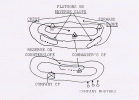I think there are many considerations:
* Attacking uphill is harder on foot.
* Spotting is usually much improved.
* Heavy weapon range is increased.
Bottom line: A good plan always wins. Few battles hang on such minutia and if they do, you are cutting things pretty thin.
I beg to differ. Quite a few battles (even up to Divisional scale battles in Italy 1944 and on the Philipines 1945, or up to Bn level on the Falklands, for instance) hung on such details.
While elevated positions may offer increased spotting ranges (eg. the hills used by German obs. elements in 1944/45, sometimes offering around 40-60 km view range) and superior heavy weapon ranges, such elevated positions are also prone to artillery barrages and air attacks, especially if they are placed on the forward slope (as displayed by wrongly placed US units in WW II, or as displayed by Argentinian troops on the Falkland Islands, who got wiped out by MILAN rockets carried by British foot units) or near the topographical crest.
While enemy forces had used reversed slopes way more often in WW II or in Corea than US units, a classic US reverse slope defense is depicted in one episode of the mini series "Band of Brothers", where German infantry had to push through the hedgerows and attack down a light slope on an open field near Carentan, which enabled the dug-in Easy company to open up when the German troops crested. When the Germans moved up their armored vehicles to reinforce the stalling infantry push, a few Shermans from Combat Command A, which was assigned to the 101st Airborne as armored reserve, were already on their way (as ULTRA had revealed the German plans for a counterattack), saving Winter's Company E in the process. The reverse slope defense was essential in slowing down the enemy and winning the battle (called "Battle of Bloody Gulch" later on, if i am not mistaken) eventually, as the Germans failed to dislodge all US defenders. The 506th PIR's left flank companies (D + F), which did not or could not use a reverse slope, had been forced to pull back, so that Company E (and the few Shermans at the end) had to bear the brunt when it faced the German spearhead.
The
501st PIR, tasked with defending the American left flank, faced the German main push, and was attacked by 2 German Panzergrenadier Bns (
37th PGR), the
3rd Bn of Fallschirmjäger-Regiment
6 and the
17. Panzer Bn. The
501st fell back under heavy pressure.
Easy Company's stiff resistance on the other flank had bought enough time so that the entire CCA could be assembled in the area, which then - with the support of Mech Inf - managed to shatter the German main push.
Another prominent example for the importance of proper unit positioning and use of elevations was the placement of a unit of the US
90. Division, in particular its Company C (1st Bn, 357th Inf), reported by 1st Bn's commander Major William DePuy:
The Company had advanced and had come up on a very high open ridge between two rivers, in early 1945. Behind the ridge was the 2nd river, and on the other side of that river there was another ridge. The Coy commander ordered his unit to dig in on the forward slope of "his" ridge. The foxholes created large doughnuts in the snow. The Germans had placed camo'ed assault guns on the top of the other ridge, and they just waited until the Coy's troops were scattered in their foxholes all over the ridge and then started to fire at them, using the brown foxholes to direct their fire.
Major DePuy:
"
It was murder. Finally, after they killed and wounded maybe 20 men in that company, the rest of them just got up and bolted out of there and went over to the reverse slope, which is where they belonged in the first place. So, being on a forward slope when the enemy has direct fire weapons, high velocity direct fire weapons, is suicide."

In mountainous regions, additional counterslopes are being used by reserve (or "Alamo") units and mortars are placed behind the 2nd crest to support the defenders on the reverse slope.

Another vital factor is the proper use of observation units and posts. As I outlined in another post (discussion regarding fast Recon Bns and fast recon vehicles), the game really needs to ...
- allow for the use of small size units and needs to render small wheeled (fast) recon units or recon foot elements (especially on mountainous maps).
- Currently, a whole company has to be placed (and EXPOSED) on top of a hill range, just to get a solid idea about the whereabouts of enemy units in view range.
- Also, it seems like view ranges are not rendered with sufficient realism, as prominent elevations of say 400 or 500 meters (and above) should provide for clear views (of up to 10-20 kilometers, at least) on clear days. Similar elevations in Germany offer view ranges of 40-80 kilometers, depending on weather (ie. the view from the Siebengebirge aka the "Seven Mountains" on the Rhine valley/lowlands, elevations near the Fulda gap and hills southeast of Stuttgart, but also elevations in the Eiffel region and the Hürtgen Forest), for example.

